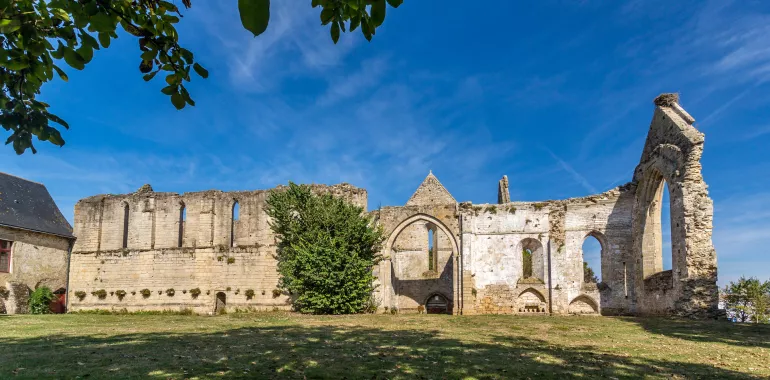arrow_back
La Garnache / Bouin Vendée Vélo Tour
Nature & small heritage
34,05 Km
2 h 16 min
I begin / Family
34,05 km cycling route from La Garnache to Bouin
On this transitional stage, the horizons are wide, allowing you to take in the landscapes for miles around as you shift from the typical hedge-divided fields of the Bocage Vendéen to the marshlands of the Marais Breton Vendéen. So, the Vendée Vélo Tour leads you on to this remarkable natural area so close to the Vendée coastline. Keep your eyes peeled as there’s a good chance you may spot, along the many tidal canals (étiers), numerous birds that nest in these parts set between land and sea and so ideally suited to them. Down the centuries, as the wetlands here were gradually drained to reclaim land from the sea and create agricultural polders, the islands that had dotted the area disappeared… although traces of them do remain.
Elevation of the stage
31 m 11 m
Waytypes of the stage
Cycle path: 10,78 km By road: 23,26 km
Surface of the stage
Smooth: 21,99 km Rough: 12,06 km
The route
You ride along country roads with little traffic, but certain stretches are on greenways. From the centre of La Garnache, follow the signs marked on the ground indicating Vendée Vélo and taking you in the direction of Châteauneuf. Then, from Châteauneuf, you’ll head for Bouin. Along the first portion of this stage, there are some gentle slopes through the middle of the hedge-divided countryside typical of the Bocage, with just the odd shaded spot. The change in landscapes becomes more marked leaving Châteauneuf for Bouin, shade becoming much rarer, as you find yourself surrounded by marshlands divided up by numerous canals. Before arriving at Bouin, take care crossing the D758, a busy road, particularly during the summer holidays.
Don't miss
- Châteauneuf :
- La Motte féodale est l'ancêtre des châteaux forts du début du moyen âge. Il s’agissait de tours de guet entourées d’une palissade, construite sur une butte de terre pouvant atteindre 10 m de haut, elle-même protégée par un fossé.
- Observatoire des cigognes, les cigognes nichent depuis plus de 30 ans dans le Marais breton Vendéen. Elles sont visibles de janvier à début août. L’observatoire, en libre accès, est situé le long de la piste cyclable au lieu-dit La Garenne.
- L’Abbaye de l’Ile Chauvet (Bois de Céné), était, comme son nom l’indique, une ancienne île. Ce monastère date du début du XIIe siècle. Ne subsistent de cette abbaye bénédictine que l’église romane et son magnifique portail, le dortoir des moines et la cuisine. L’été, ce site est ouvert aux visiteurs les après-midis de 14h à 18h (fermé le samedi).
- Bouin : ancienne île qui a attiré de grands seigneurs. Elle a connu une période faste grâce au commerce du sel, de nombreux bâtiments remarquables en sont les témoins (pavillon, château du sénéchal, église de Notre Dame)
- La Maison du Pays du Gois : Elle vous ouvre ses portes en juillet/août et vous dévoile les richesses cachées du Passage du Gois et de sa région : son littoral sauvage et préservé. (Accueil Vélo)
- Châteauneuf:
- The feudal motte, or mound, here recalls the predecessors of the fortified keeps that began to be constructed around France at the start of the Middle Ages. A traditional motte consisted of a watchtower built atop a mound of earth, up to roughly 10m in height, and surrounded by a moat and a palisade of wooden stakes… but the motte here is now topped by a statue of the Virgin.
- Observatoire des Cigognes: this observatory was designed for watching storks, who have been coming to nest in the Marais Breton Vendéen for over 30 years. They can be seen from January to early August from this spot located beside the cycle track at the place named La Garenne.
- Abbaye de l’Ile Chauvet (Bois-de-Céné): this Benedictine monastery, dating back to the start of the 12th century, was, as its name indicates, built on an island; today just its Romanesque church, with its magnificent entrance, the monks’ dormitory, and the kitchen survive. This site is open to visitors summer afternoons, 2pm – 6 pm, daily except Saturday.
- Bouin: long home to major local lords, a village came into being here on what was once an island, the lucrative salt trade bringing it wealth, as evidenced by many remarkable buildings, such as the Château du Sénéchal, the Eglise de Notre Dame and the Demeure du Pavillon.
- La Maison du Pays du Gois: open July and August, this place reveals the hidden riches of the local area around the extraordinary submersible tidal road, the Passage du Gois, and the unspoilt, well-preserved coast here. (Accueil Vélo accredited site)
SNCF train stations
- Coach services to and from Bouin - line 13 (Nantes - Noirmoutier). Note that the coaches have six spaces designed for transporting bikes.

Travellers’ reviews